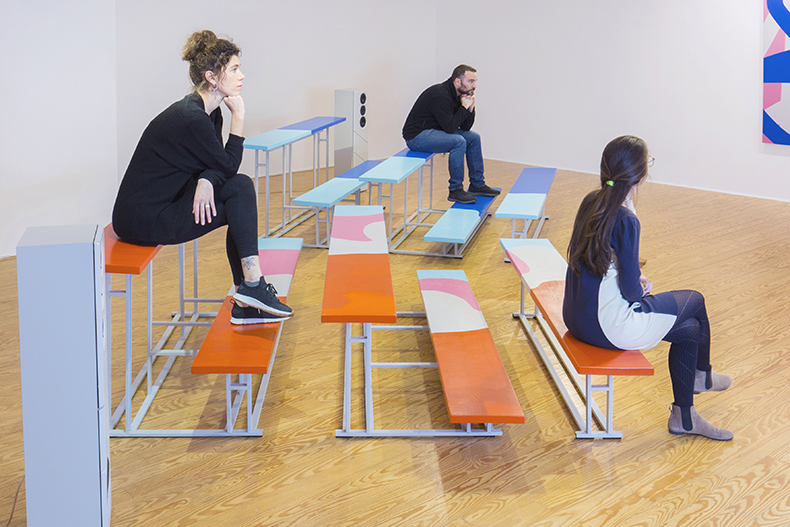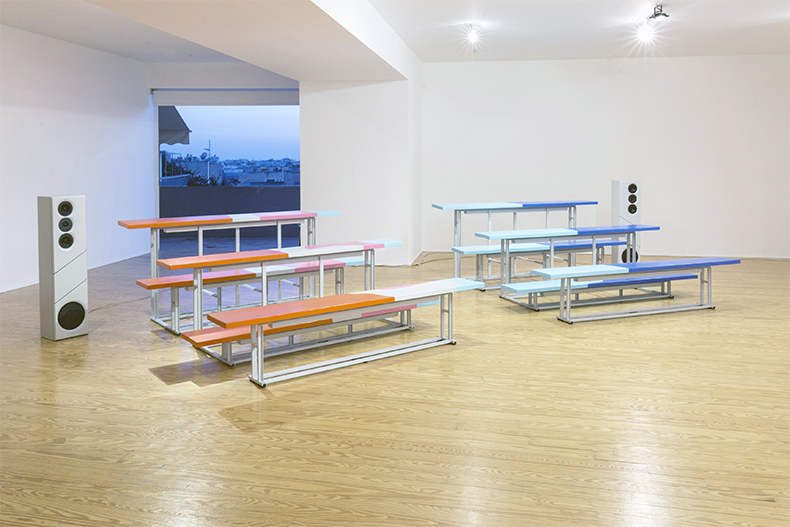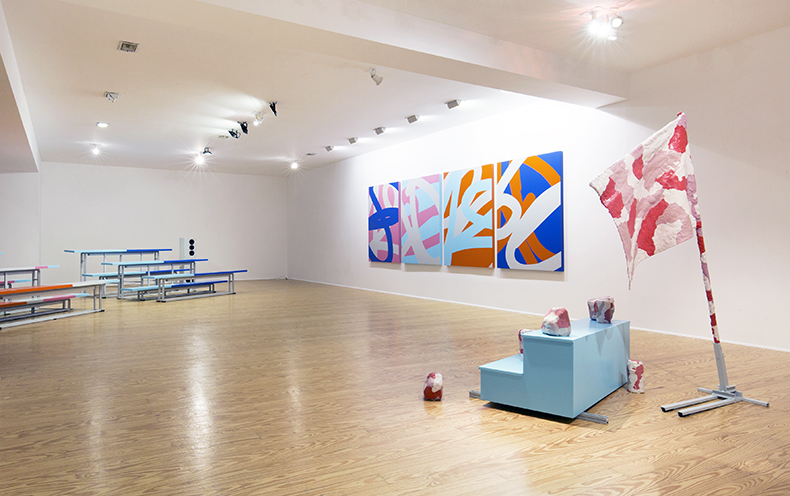Nikos Arvanitis
Twelve Hours
solo exhibition
April 6 – May 18, 2019
a.antonopoulou.art gallery, Athens, Greece

An hour’s drive, an hour of break, an hour of delay. Three hours of cooking, three hours of flight, three hours of lesson. Eight hours of work, eight hours of sleep, every eight hours antibiotics. Twelve hours.
In “Twelve hours”, Nikos Arvanitis presents a sound and space installation, which was developed using a recent episode of political speeches as a starting point. The artist chooses to isolate the structure of an extensive confrontation in the context of a critical parliament sitting and to track the speech that articulates and constitutes it. He abolishes the specifics of the positions maintaining only the methodology of their development and their factual elements, aiming to a cyclical flow and rhythm of information.
The artist presents a multi-layered "representation" of the preparation of a decision; shifting data, he attempts to synthesize a Unicode typology of the argument, reversing data into fiction. In this new context, the codes of language and speech, as well as aspects of the plot inside and outside the room, are transferred to the gallery space. The installation, invites the viewers to participate in the Hearing of this “pop-thriller”.

Twelve Hours / Statements (I,II,III,IV), water based enamel paint on wood, each 140 x 104 cm, 2019
Twelve Hours / Positions, sound, duration 30´25´´, narrators: Alexis Dallas, Nektarios Pappas, Aggeliki Soupiona, electric guitar: Apostolos Polychroniadis, 2019

Twelve Hours / Evidences, silicon, colour pigments, styrofoam, wood, iron, textile, water based enamel paint, dimensions variable, 2019

Twelve Hours / Auditorium, iron, wood, water based enamel paint, dimensions variable, 2019
Eight hours' labour, Eight hours' recreation, Eight hours' rest. Eight notes for Twelve Hours
by Eleni Michaelidi
1. In his new solo exhibition Twelve Hours, Nikos Arvanitis attempts an experimental transposition. The starting point is a recent yet historic session at the austrian parliament in July 2018. Following intense consultations, the coalition government of the conservative and far right parties, supported by the neoliberal opposition party, voted for a controversial legislation which optionally allows for the increase of working hours from eight to twelve daily, and from forty to sixty weekly. The new legislation prompted intense protests from the opposition and trade unions, which called for mass demonstrations. On the morning of the day of vote, the parliamentarians who supported the new legislature found candles, stone blocks and placards reading “Traitors of workers” placed outside their homes and offices.
2. The very procedure of debating and voting, which was transmitted live, was extremely spectacular. In parallel to pompous debates and populist outbursts, the oppositional parliamentary groups held up placards with slogans and the work hours that they either suggested or rejected, posing for selfies and cameras in an unfolding media theater of impressions. Within the context of mass politics, the deprivation of meaning, the reversal and eradication of positions are no exception, but commonplace. “There is only economic politics, and indeed only a certain type of economic politics [...] The differences between political forces are almost nullified.”(1)
3. Departing from this recent episode in the field of sovereign politics, Arvanitis constructs a multiple media installation, where he captures the tensions and connotations of the event. Focusing on individual components of the plot in and outside the parliament, he obliterates any concrete references, inviting the public to participate in a dramatized hearing. The installation is structured around three distinctive poles, which constitute a multilayered representation of a decision making process.
4. The visual depictions of the painting panels freely convey the dipoles of 12/8 and 40/60, a reference to the placards of the opposing parliamentarians and protesters. The choice of color palette reflects the identifying shades of austrian parties involved in the debate. Referring to the setup of a parliament, as much as that of a theater, square or football field, the platform construction functions as a mechanism of viewing/hearing, reinscribing the bodies of the public in the installation.
5. A second pole consists of grouped sculptural elements from silicone, with soft texture and shades reminiscent of flesh. Installed on stairs, they refer to the activist action which took place before the controversial vote. These hybrid sculptures concentrate properties as contradictory as those of stone and flesh, reflecting the restrictions of matter and suggesting the possibility to think beyond the constraints of political and aesthetic boundaries, as soft power objects. Bearing symbolic meanings and ideologies, the flag completes the group as a two-fold symbol of power and freedom.
6. The sound component, an idiosyncratic radio opera, is diffused into space, connecting the different parts. Based on the minutes of the parliamentary sitting, it proposes a reenactment of the political event which focuses selectively on elements of the plot, without any concrete reference to time, place and individuals. Arvanitis composes a theatrical performance with music elements, which either accompany dramatic tensions, either amplify noise. The limits between the event and its performative renegotiation remain liquid. This plot could be unfolding anywhere, anytime.
7. In the post-truth era, Debord’s ascertainment remains disturbingly prescient: “There is no place left where people can discuss the realities which concern them, because they can never lastingly free themselves from the crushing presence of media discourse and of the various forces organized to relay them.”(2) But if the field of sovereign politics has been corroded so much it has transformed into a fully aestheticized, meaningless process, is it still possible to articulate any kind of criticism for our contemporary condition from within the very framework that creates and sustains social suffocation?
8. By reconstructing the aestheticized dystopia of mass politics, Arvanitis’ artistic strategy puts our predetermined perception of it into question. It leaves it open to the viewer/participant to think critically on the possibilities that could emerge through the aesthetic renegotiation of a spectacular political process. Besides, this experimental transposition from the field of (bio)politics to the art field could not but bear with deeply ironic associations. The spectre of work haunts Twelve Hours, activating connotations which are inherent to artistic work itself.
(1) Anselm Jappe, L’avant-garde inacceptable. Reflexions sur Guy Debord, Éditions Léo Scheer: Paris, 2004, p. 28.
(2) Guy Debord, Comments on the Society of the Spectacle, London: Verso, 1998, p. 19.

Twelve Hours / Auditorium, iron, wood, water based enamel paint, dimensions variable, 2019

Twelve Hours, exhibition view at a.antonopoulou.art gallery, 2019
Exhibition photos by Alina Lefa.
Close Window